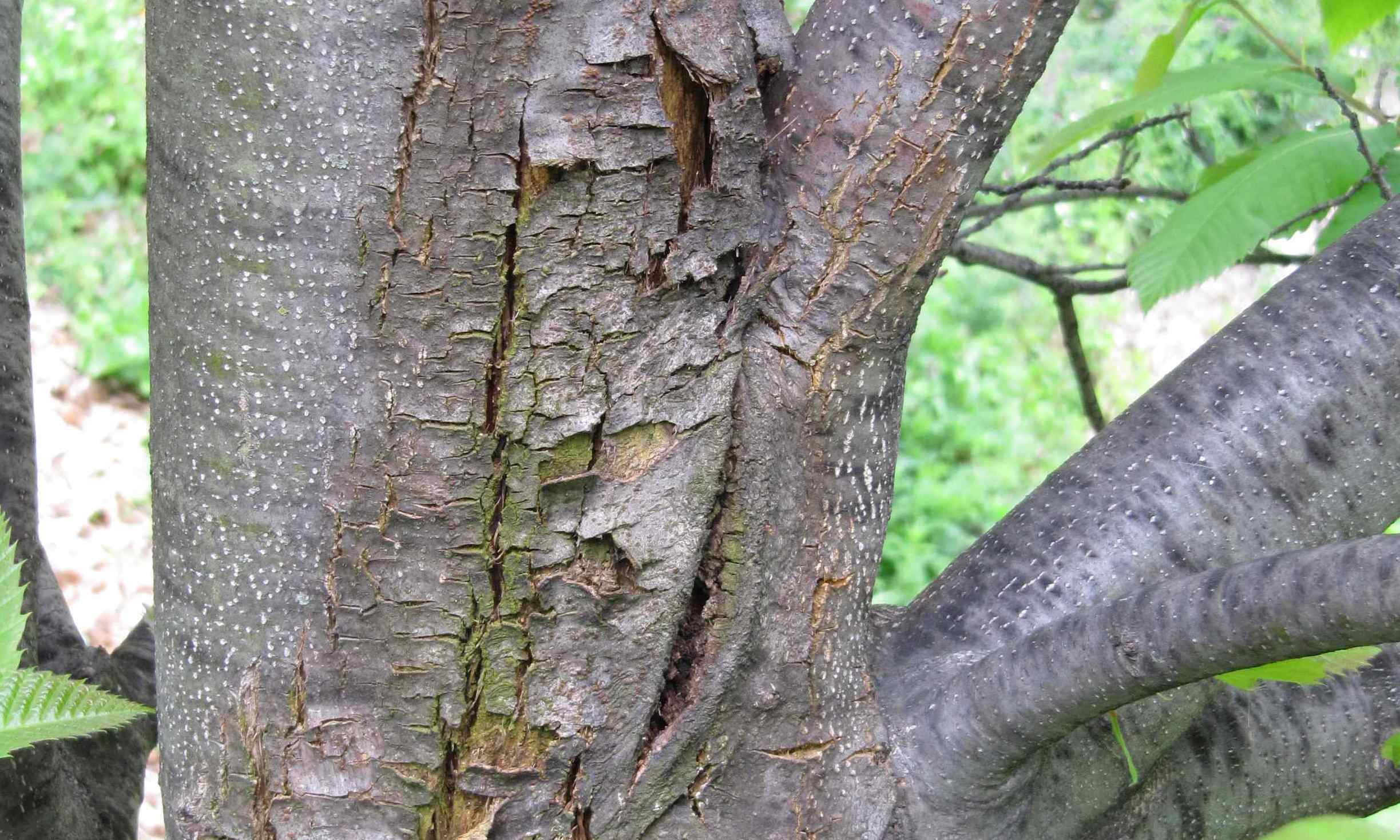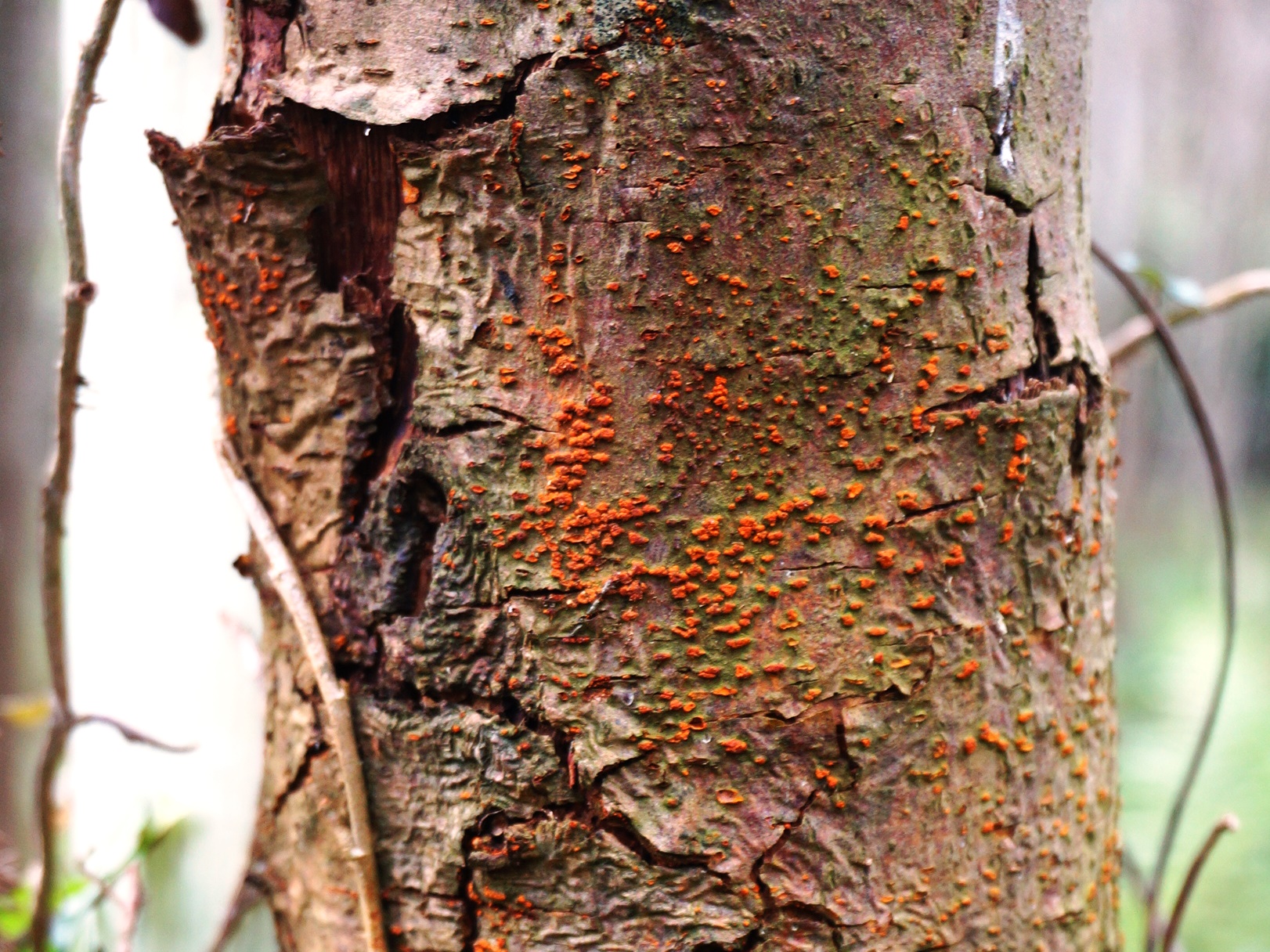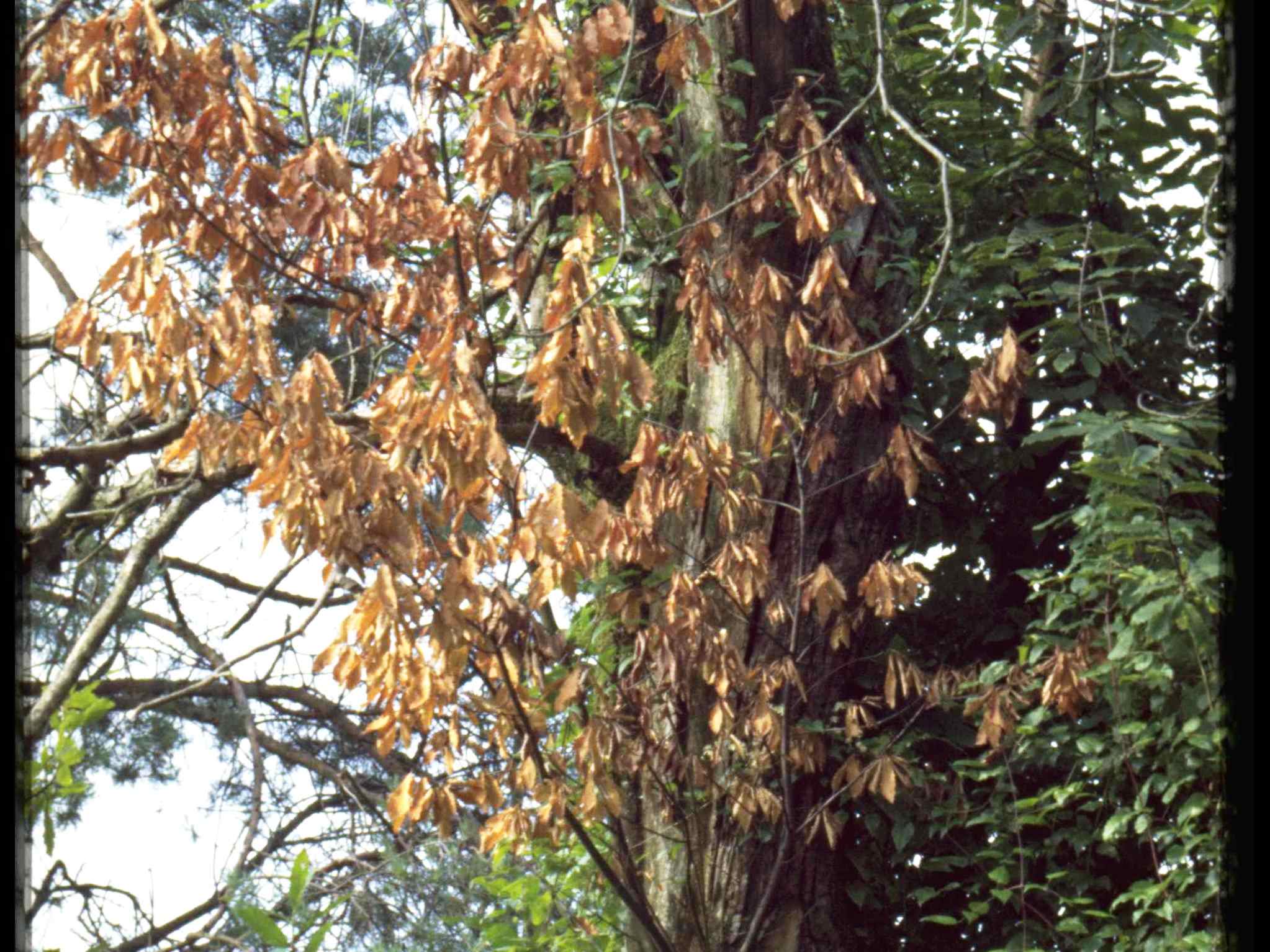Present in UK
Notifiable – see ‘Report a sighting’ below
Scientific name of causal agent – Cryphonectria parasitica

Picture: D. Rigling
Sweet chestnut blight is a destructive disease of sweet chestnut trees (trees in the Castanea genus) caused by the ascomycete fungus Cryphonectria parasitica. It was formerly known as Endothia parasitica. It can also affect a few other plant species.
Distribution
The Cryphonectria parasitica fungus has caused severe epidemics of sweet chestnut blight over large areas of North America. (See ‘Origins and background’ below.) It has also affected European sweet chestnut (C. sativa) over a wide area of continental Europe. Since 2011 it has been found on a few sites in the United Kingdom, principally in central and southern England.
The threat
C. parasitica infection is usually fatal to European (Castanea sativa) and North American (C. dentata) sweet chestnut trees. It has almost wiped out North America’s sweet chestnut population.
Although losses have not been on the same scale in Europe, sweet chestnut blight has spread steadily throughout much of Europe, and tree losses have been regionally significant.
Sweet chestnut woodland is not widely distributed in the UK. Most of it is in England, and it amounts to about 2 per cent of England’s wood cover. Most sweet chestnut woodland is in southern England, so any impact would be mostly regionally and locally felt.
Sweet chestnut trees are grown commercially for the timber and nut markets. These industries are small but locally important, particularly in Kent, where chestnut coppicing for the timber industry has been enjoying a revival during the early 21st century.
Susceptible species
C. parasitica is a serious pathogen mainly of American and European sweet chestnuts, although the latter might be less susceptible than their American relatives. The main types at risk in the UK are European sweet chestnut, which is grown for nut and timber production and for amenity purposes, and introduced plantings of American sweet chestnut.
The fungus can also occasionally affect some species of oak trees, usually when they are standing very close to heavily infected sweet chestnut trees. Susceptible oak species include Britain’s native sessile and, less often, pedunculate or English oaks (Quercus petraea and Q. robur respectively), as well as Holm oak (Q. ilex) and others. The cankers on oaks tend to be superficial bark infections which rarely cause the death of branches, sprouts or whole trees.
The European & Mediterranean Plant Protection Organization (EPPO) also lists Castanopsis species (chinquapins), Acer species (maples), Rhus typhina (staghorn sumac) and Carya ovata (shagbark hickory) as host species.
The disease poses no threat to people, pets or livestock, and it does not affect horse chestnut, or ‘conker’, trees (Aesculus hippocastanum), which are unrelated to sweet chestnut (Castanea) species. Nor is chestnut oak (Quercus prinus) affected.
Identification and symptoms
All symptoms on infected trees occur above the ground. C. parasitica attacks the bark of European sweet chestnut and enters through fissures or wounds. On grafted trees, infections are most frequently found in the region of the graft, where callusing occurs. In coppices or orchards, infections are often located at the base of the stem (collars or insertion points), although bark death does not spread into the root system.
The top picture shows bark death and cracking caused by C. parasitica infection.

Picture: Forest Research (Crown copyright)
The fungus can spread so rapidly in infected bark that stems or branches are soon girdled, and the dead bark becomes visible as a sunken canker (above). The orange fruiting bodies which produce the spores which spread the blight are also visible on the bark. These fruit bodies erupt through lenticels and exude long, orange-yellow tendrils of spores in moist weather.

Picture: D. Rigling
Above the girdling canker, leaves wilt and turn brown, but remain hanging on the tree (above). Below the canker, branches have healthy foliage and, after a short time, new shoots are produced below the area of dead bark. It is common to find many cankers on a single tree.
On young, smooth-barked branches the cankered bark can be a bright brown, in contrast to the greenish colour of normal bark. On older stem infections, the discoloration or sunken nature of the infected bark is much less obvious. When the bark is killed rapidly the stem is girdled without any callus formation.

Picture: Forest Research/Crown copyright
However, sometimes the disease’s progress is slower, and new layers of bark form under the affected areas so that swelling and subsequent cracking of the outer bark occurs (above).
Another characteristic symptom is the formation of pale-brown mycelial fans in the inner bark, although these can only be revealed by cutting away the outer bark.
Some of the symptoms caused by C. parasitica infection, such as crown dieback, can also be caused by other pathogens, including Phytophthoras such as Phytophthora cambivora and P. cinnamomi. The latter is frequently associated with ‘ink disease’, named after a blue-black stain found around damaged roots. These pathogens are already present on a range of host plant species in the UK, and have been known for many decades to cause disease on sweet chestnut.
Other organisms which can cause dieback and cankers on sweet chestnut include Diplodina castaneae, Phytophthora ramorum and forms of Amphiporthe castanea (formerly known as Cryptodiaporthe castanea).
The following resources provide more images and information to help identify sweet chestnut blight.
Please note that the contact details on the Pest Alert have been superseded by those given on this page.
Report a sighting
If, after studying the symptoms guides above, you think you have seen a case of sweet chestnut blight in Great Britain, please report it to us using TreeAlert.
Suspected sightings in Northern Ireland should be reported using TreeCheck, the all-Ireland tree disease reporting tool.
Please note that Tree Alert and TreeCheck both require digital photographs to be uploaded: these should be clear, well-lit, close-up pictures of symptoms.
If you trade in plants in England or Wales and suspect sweet chestnut blight on your site, please inform your local Animal & Plant Health Agency (APHA) plant health and seeds inspector or contact planthealth.info@apha.gov.uk; tel: 0300 1000 313.
Spread
Long-distance spread of C. parasitica can occur through movements of infected sweet chestnut plants, wood or bark in trade.
Once bark has been colonised, the mycelium of the pathogen is reported to survive in this tissue for up to 10 months, even if it has been air dried. There is also a small risk of transmission by fruits or seeds.
Locally, the spores of C. parasitica are spread by wind and water, but might also be transmitted by other agents such as insects and birds. Entry into suitable tissue for infection might be aided by wounds produced by insects, including the Oriental chestnut gall wasp (Dryocosmus kuriphilus), which is present in South-East England. Early results from our research suggest that this might be happening at some sites in England.
It is also reported that the pathogen can exist as a saprotroph (that is, it lives and feeds on dead organic matter) on broad-leaved trees beyond its parasitic host range, allowing it to persist even when infected chestnut trees have been removed. Infection can also persist on cut timber, branches and woody material.
We are conducting research to improve understanding of the disease in the UK context. At most sites where sweet chestnut blight has been found, only a few trees are affected, and very few of these appear to have been killed.
Preventing and minimising spread
Spread of the disease is best prevented or minimised by:
- destroying infected plants as soon as possible after detection, preferably on site;
- not moving infected plants, bark or wood;
- practising high standards of biosecurity, such as washing and disinfecting tools, vehicles, equipment, footwear, clothing and vehicles after visiting or working at infection sites, and before visiting or working at new sites.
See also ‘Regulation’ and ‘Official action’ below for details of regulatory measures designed to prevent or minimise further introductions and spread of sweet chestnut blight.
Regulation
C. parasitica is treated as a European Union (EU) quarantine organism, and the UK is an EU ‘protected zone’ for the organism. This means that special regulations apply to importations of sweet chestnut material, including plants, wood and bark, into the UK from other EU Member States and Switzerland. These regulations are intended to minimise the risk of further introductions of the disease into the UK. There are also regulatory requirements on importations of chestnut material from non-EU Member States.
Guidance on these regulations is available on the UK Government website for:
Official action
Sweet chestnut blight was confirmed for the first time in the UK in November 2011, in a nut orchard in Warwickshire, central England. Approximately 300 trees obtained from a supplier in France had been planted for nut production in 2007, and infection become apparent in about half of the plants.
A second outbreak was later found at a smaller nut orchard in East Sussex with 30 recently planted trees obtained from the same French supplier. A trace-forward exercise identified that a few infected trees were delivered to seven other locations in England. All the plants were traced and destroyed.
The Forestry Commission served Statutory Plant Health Notices (SPHNs) on the owners of the affected trees to uproot all sweet chestnut plants and burn them on site. Surveys of 3-kilometre (2011) and 5 km (2016) radii around the infected sites and into surrounding woodland found no further evidence of the disease.
The Animal & Plant Health Agency (APHA) contacted other recipients of plants from the same sources, as well as liaising with the European Commission and the French plant health authorities. The 2011 findings were used to inform decisions about where we carry out our annual surveys of sweet chestnut for the UK’s Protected Zone status. The UK’s EU protections were strengthened in response to the 2011 findings, including a requirement that plants must originate from pest-free areas, that is, areas officially declared free of C. parasitica.
Information from the 2011 outbreaks, and from woodland surveys, was used to update and publish the Forestry Commission’s contingency plan (below) for new disease outbreaks, and actions taken for subsequent outbreaks were in accordance with the updated plan.
A further outbreak was discovered in Devon in South-West England in December 2016. A prohibition was imposed on the movement of oak and sweet chestnut material, including plants, logs, bark, branches, foliage and firewood out of, or within, six zones in Devon and Dorset. The prohibition was to minimise the risk of spreading the disease out of the affected area. It was lifted on 27 March 2018.
Movement restrictions at affected sites are applied on a site-by-site basis, taking account of the situation in each area based on the current policy approach.
Since then we have gathered intelligence and conducted extensive research to improve understanding of the disease risk. We have also not found any evidence of spread to the wider environment from the disease sites in South-West England.
There has been a few subsequent outbreaks in England, including one in South-East London. Eradication action has been taken in all cases, except for a few trees left to further aid research into management strategies for this pathogen.
The plant health service is currently dealing with findings of sweet chestnut blight at 65 sites in England. These sites are in London, Buckinghamshire, Nottinghamshire, West Sussex, Derbyshire, Kent, Devon and Cornwall. We are continuing to investigate the situation through tracing work and surveillance activities. Legislation to prohibit the import of susceptible material has been successful as these infections are associated with trees imported prior to the introduction of the UK Protected Zone in 2014. Surveillance is ongoing at these sites to determine the extent of the disease, with a view to remove infected trees where possible.
Movement restrictions at affected sites will be applied on a site-by-site basis, taking account of the situation in each area based on the current policy approach.
Biology
The C. parasitica fungus enters the tree through injuries in the bark. It spreads to the underlying vascular cambium and wood, killing these tissues as it advances. The flow of nutrients is eventually choked off to and from sections of the tree above the infection, killing the tree above ground. The spores which spread the disease to healthy trees are produced in the orange fruiting bodies which develop on the bark of infected trees.
Origins and background
Cryphonectria parasitica originated in eastern Asia, where it occurs on indigenous sweet chestnut species. However, it causes little damage to them because Asian sweet chestnut species have adapted and become tolerant to the fungus as a result of their long co-evolution with it.
The susceptibility of American chestnut became apparent soon after the first discovery of sweet chestnut blight in New York in 1904. Within 50 years the disease had spread over the entire native range of the American sweet chestnut, from Maine in the north to Georgia in the south, and west to Ohio and Tennessee, and into Ontario and British Columbia in Canada. The result was devastation of much of the estimated 4 billion American sweet chestnut population.
It is now widespread in Europe, except for countries with EU Protected Zone (PZ) status, including Great Britain. Annual PZ surveys have been carried out in sweet chestnut woodland in Great Britain since 1993 without the disease being detected.
Some European countries and regions remain free of the disease, including the Czech Republic, Ireland, Sweden and the Greek islands of Crete and Lesvos. These countries (other than Greece) also have EU Protected Zone status for the pathogen.
Sweet chestnut blight was first identified in the UK in 2011 in Warwickshire, England. Between 2011 and 2018, the disease was identified at several sites.
It has not been possible to confirm how the pathogen entered the UK, including whether the infected plants discovered in 2011 were already infected when they were imported in 2007.
Long-term prospects
There is evidence that the pathogen can weaken in virulence in Europe, allowing infected sweet chestnut plants to recover. This weakening or attenuation in virulence is due to a phenomenon known as hypo-virulence.
Hypo-virulence results when the C. parasitica fungus is infected by a naturally occurring virus (called dsRNA hypo-virus CHV1) which limits the ability of the pathogen to grow in chestnut bark, or to produce spores. Hypo-virulence is used as a form of biological control in many European countries affected by chestnut blight.
It involves the application of hypo-virulent strains of C. parasitica to trees affected with virulent, growing cankers. The treatment converts the virulent pathogen to a less aggressive form through the action of CHV1, and this allows the trees to recover from infection. There are now chestnut sites in Europe where the disease was introduced more than 30 years ago and where CHV1 is well established, so the blight severity is low.
However, the success of hypo-virulence depends on having populations of C. parasitica with limited genetic diversity. Populations with high levels of genetic variation pose a significant obstacle to the spread of the hypo-virus, and limit its effectiveness. This appears to be the main reason why hypo-virulence has had only a limited impact in the USA, where C. parasitica populations are much more genetically variable.




